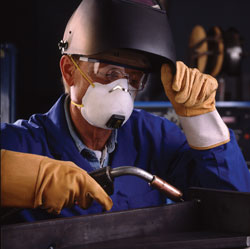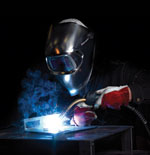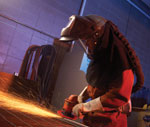
Page 3 of 3
Selecting Respirators for Hex Chrome Exposures
 On Feb. 23, 2009, a federal appeals court resolved the final challenges to the Occupational Safety and Health Administration’s Hexavalent Chromium (CrVI) Standard that was promulgated in February 2006. The last challenge argued to lower the permissible exposure limit (PEL) to 1 μg/m3 from 5 μg/m3. This appeal was denied, and OSHA’s PEL was upheld by the court. Similarly, the request to have electrical power plants be exempted from the standard was denied. The challenge involving employee notification of exposures, however, was upheld.
On Feb. 23, 2009, a federal appeals court resolved the final challenges to the Occupational Safety and Health Administration’s Hexavalent Chromium (CrVI) Standard that was promulgated in February 2006. The last challenge argued to lower the permissible exposure limit (PEL) to 1 μg/m3 from 5 μg/m3. This appeal was denied, and OSHA’s PEL was upheld by the court. Similarly, the request to have electrical power plants be exempted from the standard was denied. The challenge involving employee notification of exposures, however, was upheld.
There are three variations of the standard: General Industry (1910.1026), Construction (1910.1126), and Shipyards (1515.1026). Their requirements are very similar. The standard lowered the permissible exposure limit from 52 μg/m3 to 5 μg/m3. The action level, or the level where certain provisions of the standard such as medical surveillance may be required, is 2.5 μg/m3. There is no short term exposure limit (STEL).
The PEL, and implementation of respiratory protection and engineering controls to control exposures, took effect in November 2006 for employers with more than 20 employees and in May 2007 for employers with fewer than 20 employees. All employers have until May 31, 2010, to install feasible engineering controls. A settlement agreement in 2006 between certain challengers and OSHA allowed metal and surface-finishing operations (electroplating) to accelerate the implementation of engineering controls and therefore obtain relief from certain short-term respirator requirements. Those operations that opted into the settlement were required to implement engineering controls by Dec. 31, 2008, with the agreement from OSHA that it would not enforce the respiratory protection provisions of the standard prior to that date for most employees.
The primary industries affected, according to OSHA, are stainless steel fabrication, heavy-duty coatings and paints (automobiles, train cars, airplanes, boats, ships), electroplating, and producers of chrome-based pigments. Welding (especially on stainless steel), spraying heavy-duty coatings and paints, and chrome plating are some of the processes where hexavalent chrome can be found. CrVI exposure from any source is covered, except exposures from Portland cement and application of regulated pesticides (e.g., treatment of wood with pesticides). However, exposures resulting from sawing or sanding treated wood are covered.
Inhalation and skin contact are the primary routes through which workers are exposed to CrVI. Occupational overexposure to hexavalent chrome can result in asthma, damage to the nasal epithelia and skin, and cancer. The nasal epithelia can become ulcerated, and the septum can become perforated. Skin contact can result in irritation and allergic reactions.
Exposure Assessment
Exposure assessment is an important first step in understanding current worker exposures and determining whether further control methods, such as engineering controls and respiratory protection, are necessary. The CrVI standard permits two methods of exposure assessment. The "scheduled monitoring option" requires air sampling to make an initial characterization of worker exposures. Depending on the concentration levels, sampling may need to be repeated every three or six months. There are several acceptable monitoring methods for hexavalent chromium. Consultation with an American Industrial Hygiene Association (AIHA)-accredited laboratory can help with selection of the appropriate sampling and analytical method.
OSHA also allows the "performance-oriented option" where employees' exposures can be estimated using any combination of air sampling, historical monitoring data, or objective data. Objective data includes information such as air monitoring data from industry-wide surveys. Additionally acceptable are calculations based on material composition or chemical and physical properties of a substance demonstrating employee exposure to CrVI associated with a particular product or material or a specific process, operation, or activity. The data must reflect workplace conditions closely resembling the processes, types of material, control methods, work practices, and environmental conditions in the employer’s current operations.
Respiratory Protection
Respiratory protection requirements for hexavalent chromium are the same in the General Industry, Construction, and Shipyard standards.  Respirators are required wherever exposure levels exceed the PEL and engineering controls have not been implemented or while they are being implemented. Other situations in which respiratory protection is an acceptable control method to reduce worker exposures below the PEL include respirator use while engineering controls are being developed and implemented, if controls have been implemented but are not sufficient to reduce exposure to below the PEL, and during maintenance and repair activities for engineering controls. In addition, respiratory protection is an acceptable control method when employees are exposed above the PEL for fewer than 30 days per year and the employer has not elected to implement engineering and work practice controls, and in emergency situations.
Respirators are required wherever exposure levels exceed the PEL and engineering controls have not been implemented or while they are being implemented. Other situations in which respiratory protection is an acceptable control method to reduce worker exposures below the PEL include respirator use while engineering controls are being developed and implemented, if controls have been implemented but are not sufficient to reduce exposure to below the PEL, and during maintenance and repair activities for engineering controls. In addition, respiratory protection is an acceptable control method when employees are exposed above the PEL for fewer than 30 days per year and the employer has not elected to implement engineering and work practice controls, and in emergency situations.
The standard refers to OSHA standard 29 CFR 1910.134 for respirator selection and all other respiratory protection program elements. Employers utilizing respiratory protection must follow 29 CFR 1910.134, which includes provisions for proper selection, training, medical surveillance, fi t testing, and use. Employers also should read, understand, and follow all instructions that accompany the respirators they select.
The concentration of contaminants that is determined through the exposure assessment process is an important factor in selecting the proper respirator. Consistent with current respirator selection, half facepiece respirators, including fi ltering facepiece respirators, and full facepiece respirators with appropriate filters may be used in concentrations up to 10 times the PEL. Full facepiece respirators with appropriate filters that have been quantitatively fit-tested may be used in concentrations up to 50 times the PEL. If no oil aerosols are present, an N-series fi lter, such as an N95 fi lter, may be selected. If oil aerosols are present, an R- or P-series filter should be selected.
Powered air purifying respirator (PAPR) and supplied air respirator (SAR) systems with loose-fitting facepieces may be used in concentrations up to 25 times the PEL. PAPR and SAR systems with tight-fitting full facepieces, hoods, and helmets may be used in concentrations up to 1,000 times the PEL if the manufacturers have performance testing results consistent with OSHA requirements for use up to 1,000 times the PEL. Without this information, their use is limited to concentrations up to 25 times the PEL.
In addition to assessing the contaminant concentration, other factors that should be considered during the selection of a respirator include workers' comfort, the respirators' use with other personal protective equipment, the work environment and tasks to be performed, and the maintenance program needed.
For example, welders are one group of workers potentially exposed to hexavalent chromium. Welders using respiratory protection will need a respirator that is compatible with their welding helmet, which helps to protect their eyes from radiation from the welding arc. Welders may utilize a respiratory protection device that fits under their welding helmet or may select a system that combines a powered air purifying respirator with their welding helmet. For workers in very hot environments, a supplied air system that provides cool air and integrates with a welding helmet should be considered.
For a complete copy of the standard, please refer to OSHA’s Web site, www .osha.gov.
This article originally appeared in the May 2009 issue of Occupational Health & Safety.